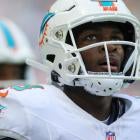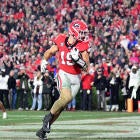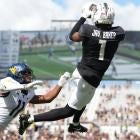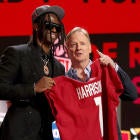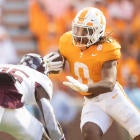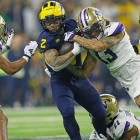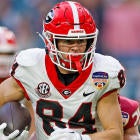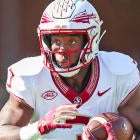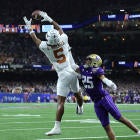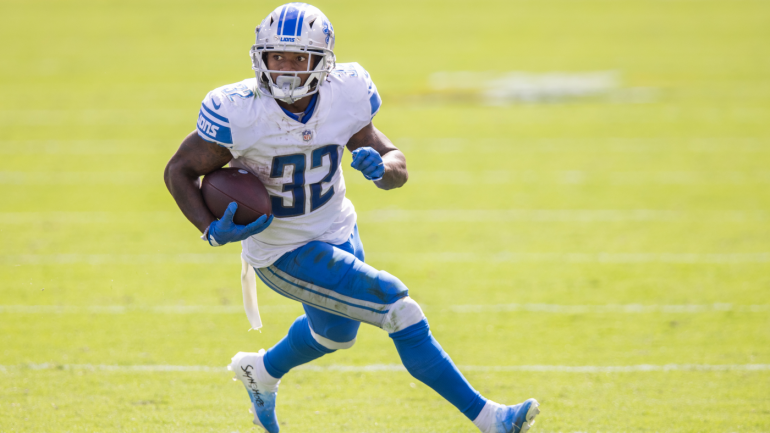
Anthony Lynn's heard and read what people have said about his offense style. They think he's more focused on running the ball and utilizing his running backs more than anything else.
"Being a former running back and all, that narrative has followed me that I'm a ground-and-pound guy," Lynn told the media in February, "and yes I've rushed for a lot of yards over the last decade. But I believe in this league, defenses are too good to be one-dimensional. You have to be balanced in your attack, your approach. That's going to be our intention, but at the end of the day, we just want to win damn games. If we've got to throw it 50 times, we will; if we've got to run it 50 times, we will. We just want to focus on winning."
When it comes to Lynn's history and tendencies, the results are mixed. It is believed he called all the plays with the Bills, but he was on the job for essentially one season, 2016, and was very run-focused. Lynn claimed that with the Chargers he "probably called a third" of the plays even though he assigned those duties to guys like Ken Whisenhunt and Shane Steichen. Those years definitely favored the pass, which isn't a stunner considering he had Philip Rivers and Justin Herbert handling the snaps.
We can emphasize Lynn's numbers in Buffalo and see what lessons he may have learned since then from his California days that could apply to his future with the Lions. From there, we can take some of his comments at face value to draw some conclusions.
New play-caller series: Falcons | Jaguars | Chargers
Pass-run ratios
| Year | Pass | Run |
|---|---|---|
| 2016 | 51 | 49 |
| 2017 | 59 | 41 |
| 2018 | 58 | 42 |
| 2019 | 63 | 37 |
| 2020 | 59 | 41 |
Again, what else would you expect when you have a savvy veteran like Rivers and a bright prospect like Herbert? They're nothing like Tyrod Taylor, who was Lynn's trusty quarterback in 2016 with the Bills. And even if Lynn called every single play, he probably wouldn't have taken the ball out of Rivers or Herbert's hands that much.
Lynn's issue in 2021 is that he's got Jared Goff at quarterback, not Rivers or Herbert. To be fair, Goff finished tied for seventh in overall adjusted completion percentage in 2020 at 78.6% (nearly three points higher than Herbert), but it slid to 62.9% -- 30th-best in the league according to Pro Football Focus -- when under pressure. He had four scores and seven picks when the pressure was on, and he was pressured the 11th-most of any quarterback in the league.
Undoubtedly, Lynn's first hurdle is to make sure Goff is supremely protected. He talked up his new offensive line, calling it the "deepest unit" on the Lions. It doesn't figure to get much of a makeover this offseason, so the squad that let up 42 sacks in 2020 will be relied upon to get better without moving in new pieces.
Point is, Lynn may not be willing to unleash Goff like he previously oversaw other quarterbacks' passing frenzies. Besides, he preached balance in his earlier comment. Tack on the Lions' receiving corps looking different than in the past, and this is a team looking at being 55% pass-tilted at the absolute most.
RB rush attempts per game
2016 Bills: 23.9
2017 Chargers: 23.8
2018 Chargers: 21.6
2019 Chargers: 21.3
2020 Chargers: 24.4
Kind of funny how the running back carries kept dipping and dipping until Herbert, a rookie, took over in 2020. Kind of interesting how the Chargers' running back carries rose once Melvin Gordon left the team. Kind of telling how Lynn's teams were always around 22-to-24 carries per game on average.
D'Andre Swift is pegged as the team's primary running back, and Lynn really seems to like him.
"I think D'Andre can be a three-down back," Lynn said. "I like his versatility, I think there's some things we can do with him in the passing game, get him a little bit more involved in that. I'm looking forward to working with this young man, we have to keep him on the field and I believe he wants to be on the field.
"We'll find someone else to go with him, but I'm excited about what I saw on tape."
Ugh, that last part. Lynn may insist on having Swift share touches, but it's not like the second-year stud out of Georgia wasn't productive despite splitting. Nine of Swift's 10 touchdowns were from inside of 10 yards, including all six rushing scores. That should keep him in line to be the short-yardage/goal-line back. He also was a large factor in the passing game. Swift did leave something to be desired in terms of carries (8.8 per matchup), but that could have been a coaching decision that should swing in his favor in 2021. Lynn's second running back in L.A. typically had 8-to-12 touches per game, leaving the rest for his lead guy. That appears to be Swift in 2021.
Reception Distribution
| Year | RB | WR | TE |
|---|---|---|---|
| 2016 | 25.6% | 51.0% | 23.4% |
| 2017 | 25.4% | 52.5% | 22.1% |
| 2018 | 30.7% | 55.5% | 13.8% |
| 2019 | 37.9% | 44.6% | 17.4% |
| 2020 | 28.8% | 51.6% | 19.6% |
Whether as a playcaller or as a head coach, there's a clear track record of Lynn's running backs being used out of the backfield. In fact, it reminded me of something Lynn told me at the NFL Owners Meeting back in 2018 about how running backs are evolving at the high school and college levels.
"It's a space game, they're making it a space game, and when you can get your best skill players in space with the ball in their hands, that's all you want," Lynn said. "You don't care if it's a handoff or a catch. You just want the guy in space. I think you're seeing more running backs being used that way."
This is the best news for Swift, who averaged 3.5 receptions per game in 2020. The worst per-game reception average Lynn's running backs had in a given season was 4.6 in Buffalo, and the best was a ridiculous 9.3 per game in 2019. Swift had four drops but did cultivate an 82.1% catch rate, a solid 7.8 yards per reception and a not-bad 7.6 yards after the catch per reception.
More importantly, the weaker Detroit's receiving corps winds up being, the more targets that could be fed to the running backs. Swift has a shot to exceed 70 receptions in Detroit provided he stays healthy, which would make up for any shortcoming he'd have in carries. He has top-12 potential in PPR leagues and top-15 potential in non-PPR formats.
Detroit's next-best Fantasy asset? That depends on whether or not Kenny Golladay stays with the team via the franchise tag or a contract extension. If he does, he'll easily be the No. 1 receiver and the likely target leader. Downgrading from Stafford to Goff at quarterback won't help -- Stafford had more deep-ball attempts and a better adjusted completion rate than Goff in four of the past five seasons. And if Golladay is head and shoulders better than Detroit's other receivers, the likelihood of him getting double-teamed in the red zone will rise.
That leaves T.J. Hockenson as Detroit's only other reliable Fantasy player. But he's someone who Lynn is a fan of, and he plays a position Lynn has leaned on. Lynn told the media that he likes to exploit the matchups his "stud" tight ends create.
"If I force you to put a DB on that guy, then obviously you have a lighter box, and you want to run the football into a lighter box," Lynn explained. "So not only does it create matchups for you in the passing game, but it also helps you in the run game. ... I think (Hockenson) could develop into that role, absolutely."
There's never been a season under Lynn where a tight end didn't see decent involvement. In fact, the only time tight ends didn't pick up at least 17% of their teams' receptions was 2018 when Hunter Henry was out for the season.
Hockenson already finished fifth in targets among tight ends in 2020, so it's not some crazy revelation that he's going to be relevant in Fantasy. But he's primed to be in a better position than he was last season when he finished seventh at his position in PPR Fantasy points per game. Plus, two-thirds of Goff's 20-point games in 2020 (and three-fourths of his 20-point games in 2019) involved a tight end putting together at least 10 PPR points. Hockenson could end up being Goff's best friend when the Lions are chasing points. I don't mind considering Hockenson a top-5 Fantasy tight end in drafts this summer.














